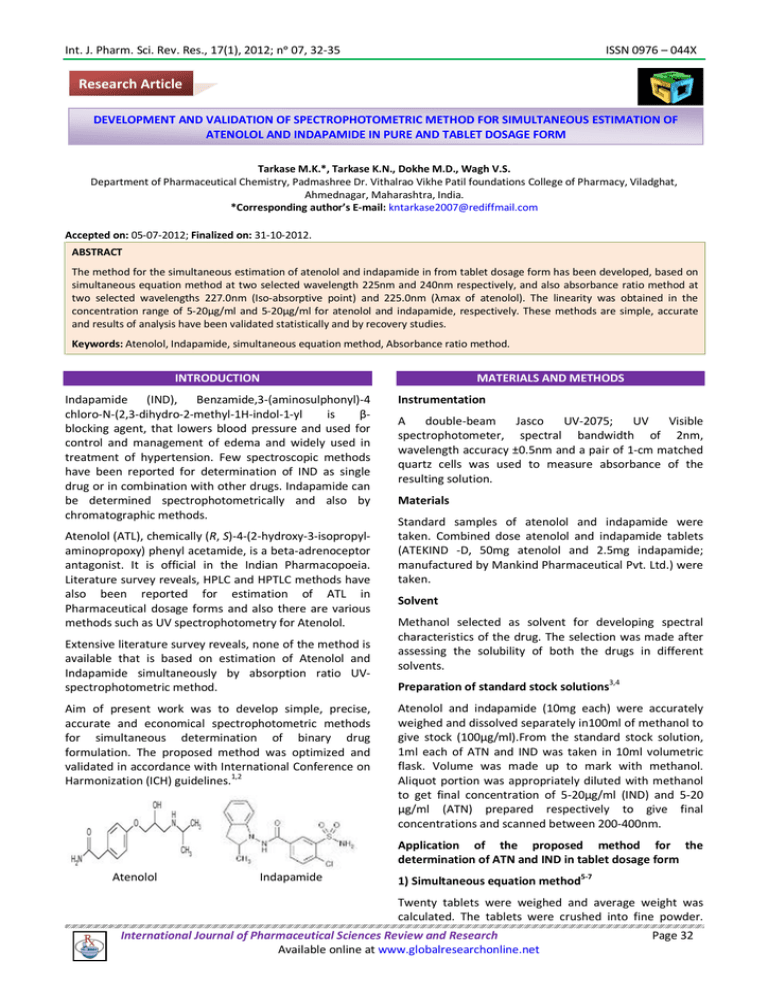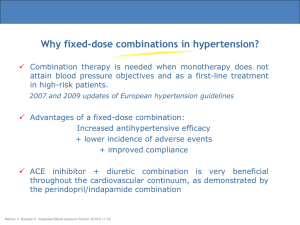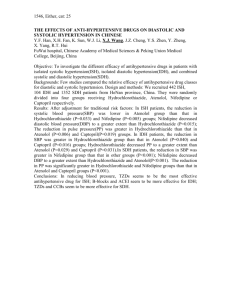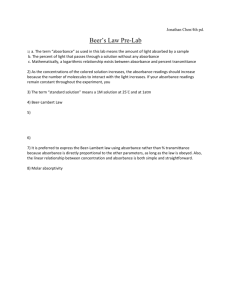Document 13308915
advertisement

Int. J. Pharm. Sci. Rev. Res., 17(1), 2012; nᵒ 07, 32-35 ISSN 0976 – 044X Research Article DEVELOPMENT AND VALIDATION OF SPECTROPHOTOMETRIC METHOD FOR SIMULTANEOUS ESTIMATION OF ATENOLOL AND INDAPAMIDE IN PURE AND TABLET DOSAGE FORM Tarkase M.K.*, Tarkase K.N., Dokhe M.D., Wagh V.S. Department of Pharmaceutical Chemistry, Padmashree Dr. Vithalrao Vikhe Patil foundations College of Pharmacy, Viladghat, Ahmednagar, Maharashtra, India. *Corresponding author’s E-mail: kntarkase2007@rediffmail.com Accepted on: 05-07-2012; Finalized on: 31-10-2012. ABSTRACT The method for the simultaneous estimation of atenolol and indapamide in from tablet dosage form has been developed, based on simultaneous equation method at two selected wavelength 225nm and 240nm respectively, and also absorbance ratio method at two selected wavelengths 227.0nm (Iso-absorptive point) and 225.0nm (λmax of atenolol). The linearity was obtained in the concentration range of 5-20µg/ml and 5-20µg/ml for atenolol and indapamide, respectively. These methods are simple, accurate and results of analysis have been validated statistically and by recovery studies. Keywords: Atenolol, Indapamide, simultaneous equation method, Absorbance ratio method. INTRODUCTION Indapamide (IND), Benzamide,3-(aminosulphonyl)-4 chloro-N-(2,3-dihydro-2-methyl-1H-indol-1-yl is βblocking agent, that lowers blood pressure and used for control and management of edema and widely used in treatment of hypertension. Few spectroscopic methods have been reported for determination of IND as single drug or in combination with other drugs. Indapamide can be determined spectrophotometrically and also by chromatographic methods. Atenolol (ATL), chemically (R, S)-4-(2-hydroxy-3-isopropylaminopropoxy) phenyl acetamide, is a beta-adrenoceptor antagonist. It is official in the Indian Pharmacopoeia. Literature survey reveals, HPLC and HPTLC methods have also been reported for estimation of ATL in Pharmaceutical dosage forms and also there are various methods such as UV spectrophotometry for Atenolol. Extensive literature survey reveals, none of the method is available that is based on estimation of Atenolol and Indapamide simultaneously by absorption ratio UVspectrophotometric method. Aim of present work was to develop simple, precise, accurate and economical spectrophotometric methods for simultaneous determination of binary drug formulation. The proposed method was optimized and validated in accordance with International Conference on 1,2 Harmonization (ICH) guidelines. MATERIALS AND METHODS Instrumentation A double-beam Jasco UV-2075; UV Visible spectrophotometer, spectral bandwidth of 2nm, wavelength accuracy ±0.5nm and a pair of 1-cm matched quartz cells was used to measure absorbance of the resulting solution. Materials Standard samples of atenolol and indapamide were taken. Combined dose atenolol and indapamide tablets (ATEKIND -D, 50mg atenolol and 2.5mg indapamide; manufactured by Mankind Pharmaceutical Pvt. Ltd.) were taken. Solvent Methanol selected as solvent for developing spectral characteristics of the drug. The selection was made after assessing the solubility of both the drugs in different solvents. 3,4 Preparation of standard stock solutions Atenolol and indapamide (10mg each) were accurately weighed and dissolved separately in100ml of methanol to give stock (100µg/ml).From the standard stock solution, 1ml each of ATN and IND was taken in 10ml volumetric flask. Volume was made up to mark with methanol. Aliquot portion was appropriately diluted with methanol to get final concentration of 5-20µg/ml (IND) and 5-20 µg/ml (ATN) prepared respectively to give final concentrations and scanned between 200-400nm. Application of the proposed method for the determination of ATN and IND in tablet dosage form Atenolol Indapamide 1) Simultaneous equation method5-7 Twenty tablets were weighed and average weight was calculated. The tablets were crushed into fine powder. International Journal of Pharmaceutical Sciences Review and Research Available online at www.globalresearchonline.net Page 32 Int. J. Pharm. Sci. Rev. Res., 17(1), 2012; nᵒ 07, 32-35 ISSN 0976 – 044X Tablet powder equivalent to 10mg of ATN was transferred to 100ml volumetric flask and ultra sonicated for 10min. The volume was made up to the mark with methanol. The resulting solution was then filtered through a whatmann filter paper (No. 41). Aliquot portion was appropriately diluted with methanol to get final concentration of 20µg/ml. The concentration of both ATN and IND were determined by measuring absorbance of sample at 225.0nm, 240.0nm in spectrum mode and values were substituted in respective formulae to obtain the concentration. Qm=ratio of absorbance of sample solution at 227.0nmand 225.0nm, Qx=ratio of absorbtivities of atenolol at 227.0nm and 225.0nm and Qy=ratio of absorbtivities of indapamide at 227.0nm and 240.0nm. 7 6 4 Cx =A2ay1 - A1ay2/ ax2 ay1-ax1 ay2 Abs CY =A1ax2 - A2ax1/ ax2 ay1-ax1 ay2 Where, 2 Cx = Concentration of ATE, Cy = Concentration of IND; A1 = Absorbance of mixture at 225nm; 0 200 250 300 Wavelength [nm] 350 400 A2 = Absorbance of mixture at 240nm; ax1= Absorptivity of ATE at 225nm; ax2 = Absorptivity of ATE at 240nm; Figure 2: Overlain or Absorbance spectra for ATE and IND in the range 200-400nm ay1 = Absorptivity of IND at 225nm; ay2 = Absorptivity of IND at 240nm Linearity Validation parameter5-8 The linearity was obtained in the concentration range of 5-20µg/ml and 5-20µg/ml for atenolol indapamide and respectively in both methods which obeys Beer-Lambert’s law. The results of the same are shown in fig 3 and fig4. 7 6 4 Linearity of Atenolol 2 Abs 225 nm 0 -1 200 240 nm 250 300 Wavelength [nm] 350 400 Absorbance 2 Figure 1: Simultaneous spectra for ATE and IND in the range 200-400nm 1 In the absorbance ratio method, from the over lay spectra of both drugs (fig-2), wavelengths227.0nm (Iso-absorptive point) and 225.0nm (λmax of indapamide) were selected for analysis. The calibration curves for atenolol and indapamide were plotted in the concentration range of 520µg/ml and 5-20µg/ml at both the wavelengths respectively. The absorptivities values were determined for both the drugs at both the wavelengths. From the following set of equations the concentration of each component in sample was calculated, 0 0 10 15 20 25 Figure 3: Linearity of Atenolol Linearity of Indapamide 2 y = 0.080x + 0.015 R² = 0.999 1.5 1 0.5 0 0 Cy=Qm-Qx/Qy-Qx .A₁/ay₁ ……….(2) Where ax₁=absorbtivity of atenolol at 225.0nm, ay₁=absorbtivity of indapamide at 2240.0nm, 5 Concentration C×=Qm-Qy/Qx-Qy .A₁/ax₁ ……… (1) and Cx=concentration of atenolol, Cy=concentration of indapamide, A₁=absorbance of sample at wavelength225.0nm, y = 0.080x + 0.015 R² = 0.999 0.5 5-7 Absorbance 2) Absorbance ratio method 1.5 5 10 15 20 25 Concentration Figure 4: Linearity of Indapamide Accuracy To ascertain the accuracy of the proposed methods, recovery studies were carried out by standard addition method at Table (1) and Table (2). International Journal of Pharmaceutical Sciences Review and Research Available online at www.globalresearchonline.net Page 33 Int. J. Pharm. Sci. Rev. Res., 17(1), 2012; nᵒ 07, 32-35 ISSN 0976 – 044X Limit of detection (LOD) and Limit of quantitation (LOQ) The LOD and LOQ by proposed methods were determined using calibration standards. LOD and LOQ were calculated as 3.3s/S and 10s/S, respectively, where S is the slope of the calibration curve and s is the standard deviation of response. The results of the same are shown in Table (1) and Table (2). Results of analysis of tablet formulation Table 1: Simultaneous equation method Drug Label Claim (µg/ml) ATN 50mg/tab IND 2.5mg/tab Amount Taken Amount % Recovery (mg/tab) Found (mg) 9.90 99 10 9.90 99 9.95 99.5 0.495 99 0.5 0.495 99 0.497 99.4 S.D S.E C.V LOD (µg/ml) LOQ (µg/ml) 0.368 0.184 0.371 0.015 0.046 0.230 0.115 0.231 0.009 0.028 S.D: Standard Deviation, S.E: Standard Error, C.V: Coefficient Variation Table 2: Absorbance ratio method Drug Label Claim (µg/ml) Amount Taken (mg/tab) ATN 50mg/tab 10 IND 2.5mg/tab 0.5 Amount Found(mg) 8.95 8.84 8.95 0.447 0.442 0.447 % Recovery 89.5 88.4 89.5 89.4 88.4 89.4 S.D S.E C.V LOD (µg/ml) LOQ (µg/ml) 0.630 0.315 0.708 0.025 0.078 0.577 0.280 0.649 0.023 0.072 S.D: Standard Deviation, S.E: Standard Error, C.V: Coefficient Variation RESULTS AND DISCUSSION From the proposed research, it was found that atenolol and indapamide obeys linearity within the concentration range 5-20µg/ml and 5-20µg/ml respectively. Percentage label claim for ATN and IND in tablet, by simultaneous equation and absorption ratio methods was found in the range of 99% to 99.6% and 88% to 90% respectively. For Coefficient of variation (CV) were calculated, which was found to be less than 2% indicating the both method has good reproducibility. Accuracy of proposed methods was ascertained by recovery studies and results are expressed as %recovery. Percent recovery for ATN and IND by simultaneous equation and absorption ratio method was found in range of 99% to 99.6% and 88% to 90% respectively, values of standard deviation, standard error and coefficient of variation for both method were in range of 0.230 to 0.368 and 0.577 to 0.630; 0.115 to 0.184 and 0.285 to0.315; 0.231 to0.371 and 0.649 to 0.708 respectively indicating the accuracy of proposed method. CONCLUSION Based on the results obtained, it is found that the proposed methods are accurate, precise, reproducible and economical and can be employed for routine quality control of atenolol and indapamide in combined dose tablet formulation. Acknowledgements: The author is thankful to Glen mark Pharmaceutical Pvt. Ltd., Nashik and Zydus Cadila Healthcare Ltd., Mumbai for providing active pharmaceutical ingredients, also to the Padmashree Dr.Vithalrao Vikhe Patil College of Pharmacy, Ahmednagar (MH) for providing necessary facilities to carry out research work. REFERENCES 1. Veerasekaran V, Katakdhond SJ, Kadam SS, Rao JR, Simultaneous determination of hydrochlorthiazide and metoprolol tartrate from combined dosage form, Indian Drugs, 38,2001,187–189. 2. Barary M. H., Determination of Hydrochlorothiazide and AlprenololHydrochloride in combinations, Indian J. Pharm. Sci.,46,1984,224. 3. Jain SK, Jain D, Tiwari M, Chaturvedi SC, Simultaneous spectrophotometric estimation of Propanolol and Hydrochlorothiazide in formulation, Indian J Pharm Sci, 64,2002, 267-76 4. Suhagia BN, Shah RR, Pate DM, Development of RP-HPLC method for Losartan potassium and Hydrochlorothiazide, Indian J Pharm Sci, 67,2005, 37-42. 5. Sachan A, Jain DK, Trivedi P, Simultaneous estimation of Captopril and hydrochlorothiazide in two components tablets by ultraviolet absorption spectrophotometry, Indian Journal of Pharmaceutical sciences, 59(1),1997, 29-31. 6. Bonazzi D, Gotti R, Andrisano V, CavriniV,Derivative UV spectrophotometric determination of atenolol and metoprolol in single and multicomponent pharmaceutical dosage forms, Farmaco,51,1996,733. International Journal of Pharmaceutical Sciences Review and Research Available online at www.globalresearchonline.net Page 34 Int. J. Pharm. Sci. Rev. Res., 17(1), 2012; nᵒ 07, 32-35 7. Erram S. V., Tipnis H. P., Simple spectrophotometric analysis of Acebutanol hydrochloride and Atenolol in combined pharmaceutical dosages with Hydrochlorothiazide Indian Drugs, 30, 1993, 462 8. Prasad CVN, Parihar C, Sunil K, ParimooP, Simultaneous determination of amiloride HCl, hydrochlorothiazide and atenolol in combined formulations by derivative spectroscopy, J Pharm Biomed Anal, 17,1998, 877-84. 9. ISSN 0976 – 044X th 10. Tripathi K.D., Essential of Medical Pharmacology, 5 Ed., Jaypee Brothers Medical Publishers (P)Ltd., New Delhi, 2003. 11. Williams A., Foye’s Principles of Medicinal Chemistry, 5th Ed., published by B.I. Publications Pvt. Ltd., 2004. 12. Beckett A.H. and Stenlake J.B., pratical pharmaceutical chemistry, 4th.Edn.The press of university of London, New Delhi, 1999, 281. Indian Pharmacopoeia, Government of India, Ministry of Health and Family Welfare, Delhi,1996, p. 72. *********************** International Journal of Pharmaceutical Sciences Review and Research Available online at www.globalresearchonline.net Page 35




